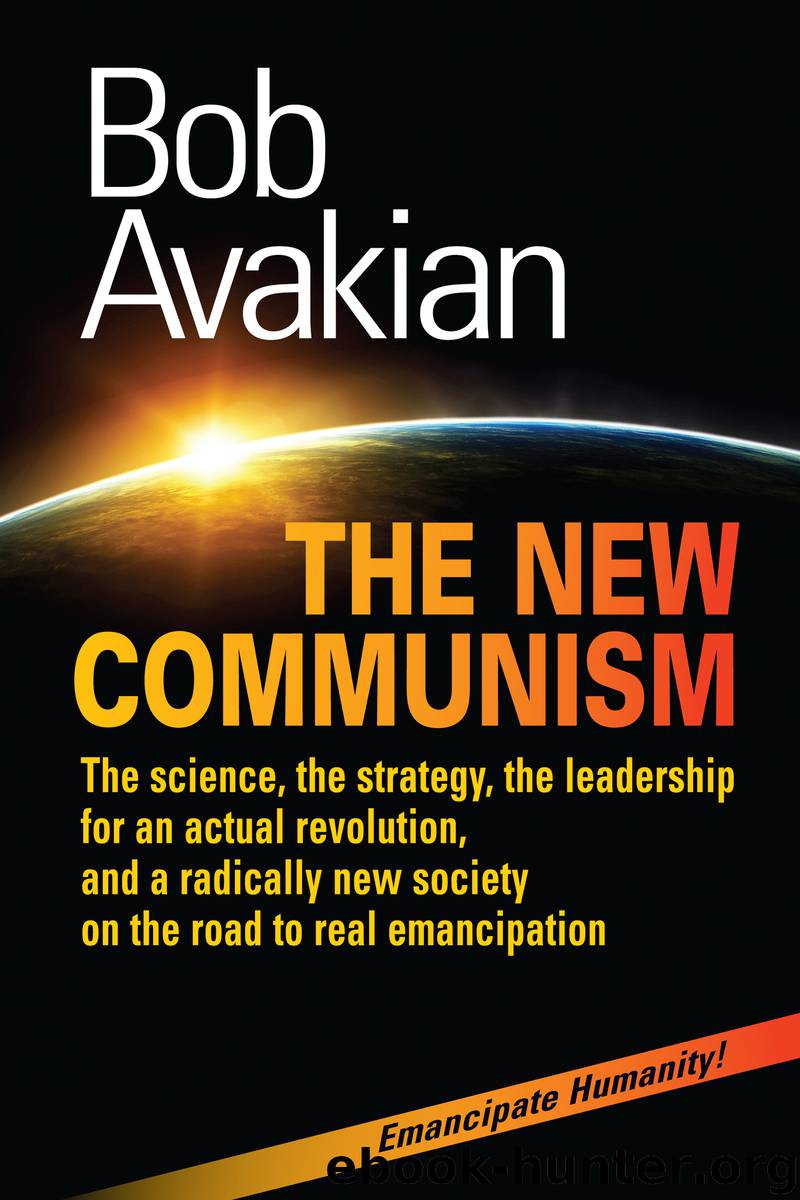NEW COMMUNISM by Avakian Bob

Author:Avakian, Bob
Language: eng
Format: epub
Tags: African-American;Avakian;communism;dialectical materialism;epistemology;exploitation;humanity;idealism;internationalism;materialism;morality;philosophy;politics;religion;revolution;slavery;social justice;socialism;new synthesis;Science.
Publisher: Insight Press
Published: 2017-07-25T20:30:25+00:00
Separation of the Communist Movement from the Labor Movement, Driving Forces for Revolution
With this understanding and orientation, let’s look further at the question of forces for, and the strategic approach to, this revolution. First of all—briefly, but importantly—on the bedrock and driving forces. In the Outline on the new synthesis of communism, one of the components of this new synthesis that’s pointed to is the separation of the communist movement from the labor movement. This is a very important point.
In early Marxism, there was a more or less direct identification of the organized working class in large-scale production, and an increasingly unionized working class, as the main base and backbone force for a revolution, or for socialism (whatever people’s idea was of that). And you still find these various opportunist groups, Trotskyites and others, who all the time want to talk about the labor movement and the trade unions as somehow the basis for socialism. Now, I don’t have time to go into everything about this, but it’s important to recognize—and this has been pointed out in different writings and talks of mine—that, over time, there has been an increasing separation of the communist movement from the labor movement. Not to say that the proletariat, or the working class, that’s employed, is not an important part of the proletarian revolution. That’s not the point; the point is that it’s not out of the dynamics of the trade unions, or even the workers in large-scale production, that the driving forces, and the main fighting forces, for revolution are going to come.
Now, if we look at this historically, we see that in the Chinese revolution Mao had to go directly up against this, because in the revolution in Russia, the first successful socialist revolution in history (leaving aside the short-lived and quickly crushed Paris Commune in 1871), even though Russia was a country largely made up of peasants (small farmers), there was a newly developing proletariat in the urban areas, and the Russian communists (the Bolsheviks, as they were called) did base the uprising, which kicked off the revolution in Russia, mainly in the urban areas among the workers in the factories, as well as some of the soldiers and sailors that were in the armed forces of the Russian government, but came over to revolution. But then this problem came more sharply to the fore: This was a largely peasant country and, unfortunately, the Bolsheviks hadn’t done much work among the peasantry, they didn’t really know much about the peasantry when the revolution started up. This posed some acute contradictions for them. That’s not to say that the way they proceeded wasn’t correct for the situation they were in, but this did involve some real problems. And then, when it came to the Chinese revolution, the communists there tried to carry out the revolution, at first, on the basis of the Russian revolutionary model, and they got crushed. They tried to have uprisings of the workers in the urban areas of China, when these workers made up a tiny percentage of the population.
Download
This site does not store any files on its server. We only index and link to content provided by other sites. Please contact the content providers to delete copyright contents if any and email us, we'll remove relevant links or contents immediately.
| Anarchism | Communism & Socialism |
| Conservatism & Liberalism | Democracy |
| Fascism | Libertarianism |
| Nationalism | Radicalism |
| Utopian |
The Secret History by Donna Tartt(18844)
The Social Justice Warrior Handbook by Lisa De Pasquale(12141)
Thirteen Reasons Why by Jay Asher(8792)
This Is How You Lose Her by Junot Diaz(6794)
Weapons of Math Destruction by Cathy O'Neil(6142)
Zero to One by Peter Thiel(5685)
Beartown by Fredrik Backman(5596)
The Myth of the Strong Leader by Archie Brown(5425)
The Fire Next Time by James Baldwin(5248)
How Democracies Die by Steven Levitsky & Daniel Ziblatt(5127)
Promise Me, Dad by Joe Biden(5087)
Stone's Rules by Roger Stone(5026)
A Higher Loyalty: Truth, Lies, and Leadership by James Comey(4843)
100 Deadly Skills by Clint Emerson(4840)
Rise and Kill First by Ronen Bergman(4701)
Secrecy World by Jake Bernstein(4644)
The David Icke Guide to the Global Conspiracy (and how to end it) by David Icke(4624)
The Farm by Tom Rob Smith(4435)
The Doomsday Machine by Daniel Ellsberg(4415)
